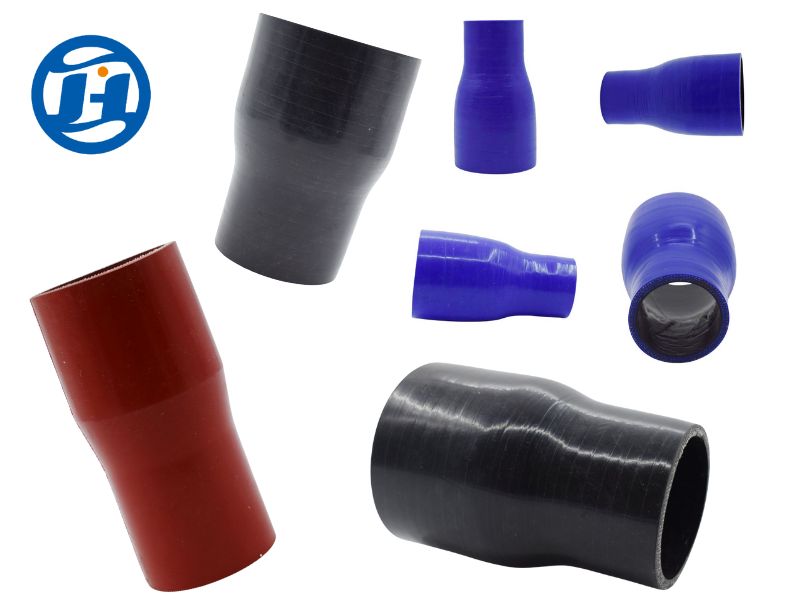What Are You Looking For?


In the automotive industry, the need for efficient, durable, and high-performance components is paramount. One such component that plays a crucial role in ensuring smooth engine operation and fluid transfer is the silicone reducer hose. These hoses are designed to connect pipes or tubes of different diameters, allowing for smooth transitions between various components in the vehicle's systems. Given the demanding conditions in automotive applications, silicone reducer hoses are increasingly favored for their flexibility, temperature resistance, and durability.
This article explores the significance of silicone reducer hoses in automotive applications, focusing on how they contribute to engine performance, safety, and the overall efficiency of the vehicle.
A silicone reducer hose is a flexible hose made from high-quality silicone rubber, which is engineered to connect two pipes, tubes, or fittings of different sizes. The hose typically has a tapered shape, with one end wider than the other, to provide a smooth transition between the two differing diameters. Silicone is the material of choice due to its outstanding properties, including excellent temperature resistance, flexibility, chemical resistance, and long-term durability.
In automotive applications, these hoses are used to transfer fluids, air, and gases throughout the vehicle's engine and auxiliary systems. Silicone reducer hoses are often found in turbocharged systems, air intake systems, cooling systems, and exhaust systems, where precise fluid transfer and high-temperature resistance are crucial.
Automotive engines generate extreme heat, and components like intake manifolds, intercoolers, and exhaust systems are often exposed to temperatures ranging from 100°C (212°F) to 200°C (392°F) or higher. Silicone is a material renowned for its ability to withstand such high temperatures without degrading or losing flexibility. Unlike traditional rubber hoses, which can become brittle or crack under heat stress, silicone hoses maintain their structural integrity and performance even in the most demanding conditions.
For example, in a turbocharged vehicle, silicone reducer hoses connect the turbocharger to the intake manifold, where the air is compressed before being fed into the engine. These hoses need to withstand the high temperatures generated by the turbocharger and prevent failure under pressure.
Automotive systems are exposed to a wide range of chemicals, including oils, fuel, coolant, and other fluids. Silicone hoses are highly resistant to most automotive fluids, ensuring that they do not degrade or react with the substances they come into contact with. This resistance to chemicals makes silicone reducer hoses ideal for fuel systems, coolant lines, and other fluid transfer applications in vehicles.
In high-performance or racing cars, where engine fluids like coolant and oil are subjected to intense conditions, silicone hoses help ensure that the system remains leak-free and efficient, even when exposed to aggressive chemicals.
One of the standout features of silicone reducer hoses is their exceptional flexibility. This flexibility allows the hoses to bend and flex without cracking or kinking, making them easy to install in tight or complex spaces within the vehicle’s engine bay. In racing cars, custom setups, or modified vehicles, where non-standard hose routing is often required, silicone hoses provide the adaptability needed for smooth installation and operation.
Additionally, silicone is highly durable and resistant to abrasion. Automotive hoses are often subjected to vibration, friction, and constant movement, all of which can cause wear and tear over time. Silicone hoses are designed to withstand these stresses, reducing the likelihood of hose failure and extending their service life.
Automotive engines generate significant vibrations, which can cause wear on components and lead to premature failure if not properly mitigated. Silicone hoses are excellent at absorbing vibrations, preventing damage to both the hose itself and the surrounding components. This is particularly important in high-performance or race cars, where engine vibrations are more pronounced, and the potential for hose damage is higher.
By reducing the impact of engine vibrations, silicone reducer hoses contribute to the overall longevity and reliability of the vehicle’s systems, ensuring that fluid and air transfer remains smooth and uninterrupted.
In performance vehicles, weight reduction is a crucial factor. Silicone hoses are lightweight compared to traditional rubber hoses, contributing to an overall reduction in the vehicle's weight. This can have a positive effect on performance, especially in racing applications where every ounce counts.
Silicone hoses are also available in a variety of colors, including red, blue, black, and more. This aesthetic appeal makes them a popular choice among car enthusiasts and racers who want to add a custom look to their engine bay while maintaining high-performance functionality.
Silicone reducer hoses are used in a variety of automotive systems, each with its unique set of requirements. Some of the most common applications include:
In turbocharged or supercharged vehicles, silicone reducer hoses are essential for transferring compressed air from the turbo or supercharger to the engine’s intake manifold. These hoses must withstand high pressure and temperature fluctuations, as well as constant exposure to exhaust gases. Silicone hoses are able to handle these extreme conditions, ensuring a steady flow of air to the engine while preventing hose failure or leaks.
Silicone hoses are particularly important in performance or racing vehicles, where the demand for maximum airflow and reliability is critical.
Silicone reducer hoses are commonly used in automotive cooling systems to transfer coolant between the radiator, engine block, and other components. Given the high temperatures involved in cooling systems, silicone’s heat resistance makes it an ideal material for this application. Silicone hoses are able to endure the fluctuating pressures and temperatures found in cooling systems without cracking, leaking, or degrading over time.
In addition, silicone hoses provide excellent sealing properties, reducing the risk of coolant leaks that could lead to engine overheating or failure.
The intake system is crucial for engine performance, as it controls the flow of air into the engine. Silicone reducer hoses are used to connect air intake components, such as the air filter, throttle body, and intake manifold. These hoses help maintain optimal airflow while offering the flexibility needed to route the hoses through tight engine bays.
The ability of silicone hoses to resist heat and chemicals ensures that air intake systems continue to function at peak efficiency, even under demanding conditions.
Exhaust systems in vehicles are subjected to high temperatures and harsh conditions. Silicone reducer hoses are used to connect various parts of the exhaust system, such as the exhaust manifold, turbochargers, and downpipes. These hoses help to reduce the risk of exhaust leaks, which can affect engine performance and lead to environmental issues.
In high-performance vehicles, silicone hoses are often used to ensure efficient exhaust flow and prevent any backpressure that could reduce engine output.
Vacuum hoses and breather systems in vehicles require high-performance hoses that can withstand both heat and pressure. Silicone reducer hoses are ideal for this purpose, as they ensure a tight seal while maintaining flexibility. These hoses are used to transfer air or gases within the engine’s vacuum and breather systems, helping to maintain proper engine function and reduce emissions.
Silicone reducer hoses play a critical role in the automotive industry, providing a reliable, flexible, and durable solution for connecting components of different sizes within a vehicle’s systems. Their ability to withstand extreme temperatures, resist chemicals, and endure the stresses of vibration and pressure makes them indispensable in automotive applications, from performance engines to everyday vehicles. Whether it’s in the turbocharging system, cooling system, intake system, or exhaust system, silicone hoses help ensure that fluids and gases are transferred efficiently, safely, and reliably. With their superior performance, aesthetic appeal, and long-lasting durability, silicone reducer hoses are an essential part of modern automotive engineering.
